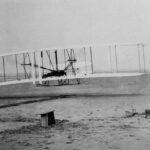The question of “How Safe Flying” is a common one, especially for those who don’t frequently travel by air. It’s often framed by comparing the perceived risks of flying in different types of aircraft. Specifically, how does flying in a small, single-engine airplane compare to the safety of a large commercial airliner? While all forms of aviation inherently involve managing risks, the reality is that scheduled airline travel boasts a significantly lower risk profile than general aviation (GA) in smaller aircraft.
Statistically, general aviation, which includes private and recreational flying, experiences a considerably higher accident rate compared to commercial airlines. To understand the scale, in 2017, General Aviation pilots in the US flew approximately 25 million hours. During that same year, the National Transportation Safety Board (NTSB) data indicated a startling 10.617 total accidents and 1.977 fatal accidents per 100,000 flight hours in GA. In stark contrast, commercial airlines, with only four fatalities over the past decade, have such low accident rates they are statistically negligible. For perspective, road vehicle fatalities are around 0.6 deaths per 100 million passenger miles, a figure dwarfed by GA accident statistics when directly compared per flight hour. The NTSB even states that the death rates for airline passengers per 100,000 flight hours are statistically almost zero.
Why the Disparity in Safety Records? Factors Contributing to Airline Safety
The vast difference in safety records between general aviation and commercial airlines is not due to chance. It stems from a multitude of factors meticulously built into the commercial aviation system:
Stringent Aircraft Certification and Regulatory Standards
Commercial airlines operate aircraft certified under Part 25 of aviation regulations. These “Transport Category” aircraft are designed, tested, and certified to a much more rigorous set of safety standards than those applied to general aviation aircraft (typically certified under Part 23 for normal category airplanes). This includes more demanding requirements for structural integrity, engine reliability, and system redundancy.
Enhanced and Proactive Maintenance Programs
Scheduled Air Carriers (SACs) are mandated to adhere to far more stringent maintenance programs than those legally required for general aviation aircraft under Part 91. Airlines employ dedicated teams and sophisticated systems for continuous monitoring, inspection, and preventative maintenance, ensuring aircraft are consistently maintained to the highest standards.
Comprehensive Flight Planning and Operational Support
Airline flights are not planned by a single individual. Instead, they benefit from the expertise of teams specializing in various critical areas. This includes meteorologists providing detailed weather forecasts, fuel management experts optimizing fuel loads, and flight planners ensuring efficient and safe routes. This collaborative approach minimizes risks associated with flight preparation.
Highly Qualified and Continuously Trained Flight Crews
Airline pilots hold Airline Transport Pilot Certificates, the highest level of pilot certification, requiring extensive training and experience. They accumulate significantly more flight hours, often in diverse and challenging conditions, compared to many general aviation pilots. Furthermore, airline pilots are type-rated for the specific aircraft they fly, undergoing rigorous annual recurrent training, and must maintain a first-class medical certificate, ensuring peak physical and mental condition.
Instrument Flight Rules (IFR) and Air Traffic Control (ATC) Oversight
Commercial airline flights operate under Instrument Flight Rules (IFR), even in good weather conditions. This means they rely on instruments for navigation and are continuously under the guidance and surveillance of Air Traffic Control (ATC). ATC provides separation services, monitors flight progress, and offers critical support in emergency situations, significantly enhancing safety.
Advanced Aircraft Technology and System Redundancy
Transport Category airplanes are predominantly turbine-powered and pressurized, enabling them to operate at higher altitudes, above most adverse weather conditions. They are equipped with advanced anti-icing and de-icing systems and procedures, both pre-flight and in-flight. Crucially, many are multi-engine aircraft, designed to maintain performance even with an engine failure, offering substantial redundancy and safety margins.
General Aviation: Managing Risks Through Pilot Skill and Diligence
General Aviation aircraft, often operated under Part 91 for recreational flying, typically do not incorporate the same levels of redundancy and support systems found in commercial aviation. Pilots often hold only a Private Pilot Certificate and are solely responsible for all aspects of flight planning, preparation, and execution. Aircraft maintenance may be less intensive, and operations frequently occur at smaller, uncontrolled airports with less support infrastructure.
However, it’s crucial to recognize that a capable, well-informed, and diligent general aviation pilot can operate a light airplane safely. By employing meticulous flight planning, sound judgment, and adhering to best operating practices, GA pilots can effectively mitigate many of the inherent risks.
Pilot error is consistently identified as the primary cause in over 85% of aviation accidents. A review of general aviation accident reports frequently reveals that accidents are often linked to poor pilot decision-making, hazardous attitudes, succumbing to pressure, or operating outside of personal limitations. These incidents often result from a chain of seemingly small errors and misjudgments, highlighting the critical importance of pilot skill, knowledge, and responsible aeronautical decision-making.
As the quote attributed to A.G. Lamplugh wisely states: “Aviation itself is not inherently dangerous. But, to an even greater degree than the Sea, it is terribly unforgiving of carelessness, incapacity, and neglect.“
This underscores that while general aviation statistically carries a higher risk, flying, in general, is managed through rigorous systems and procedures, and ultimately, pilot proficiency and responsible conduct are paramount to ensuring the safety of any flight.
